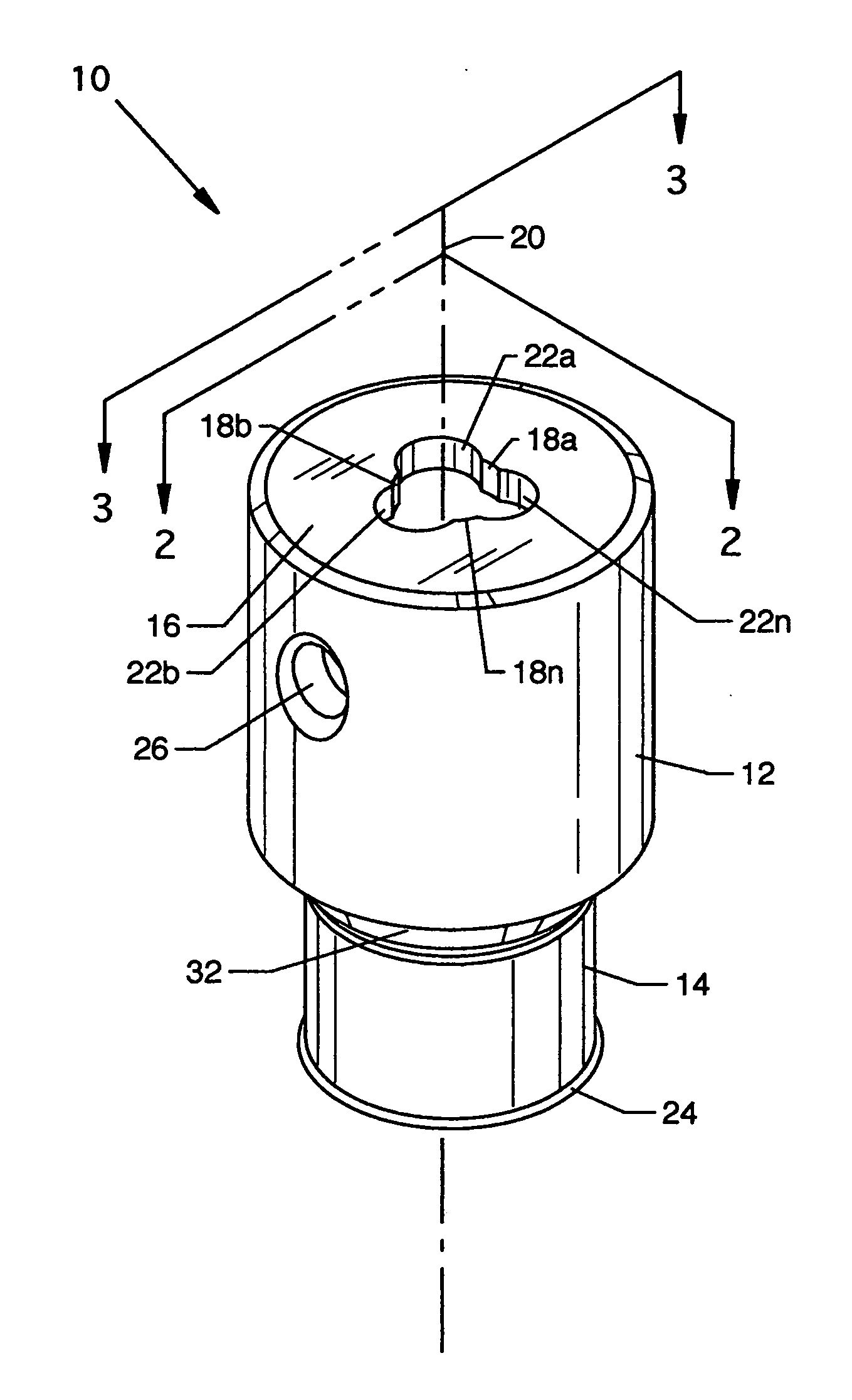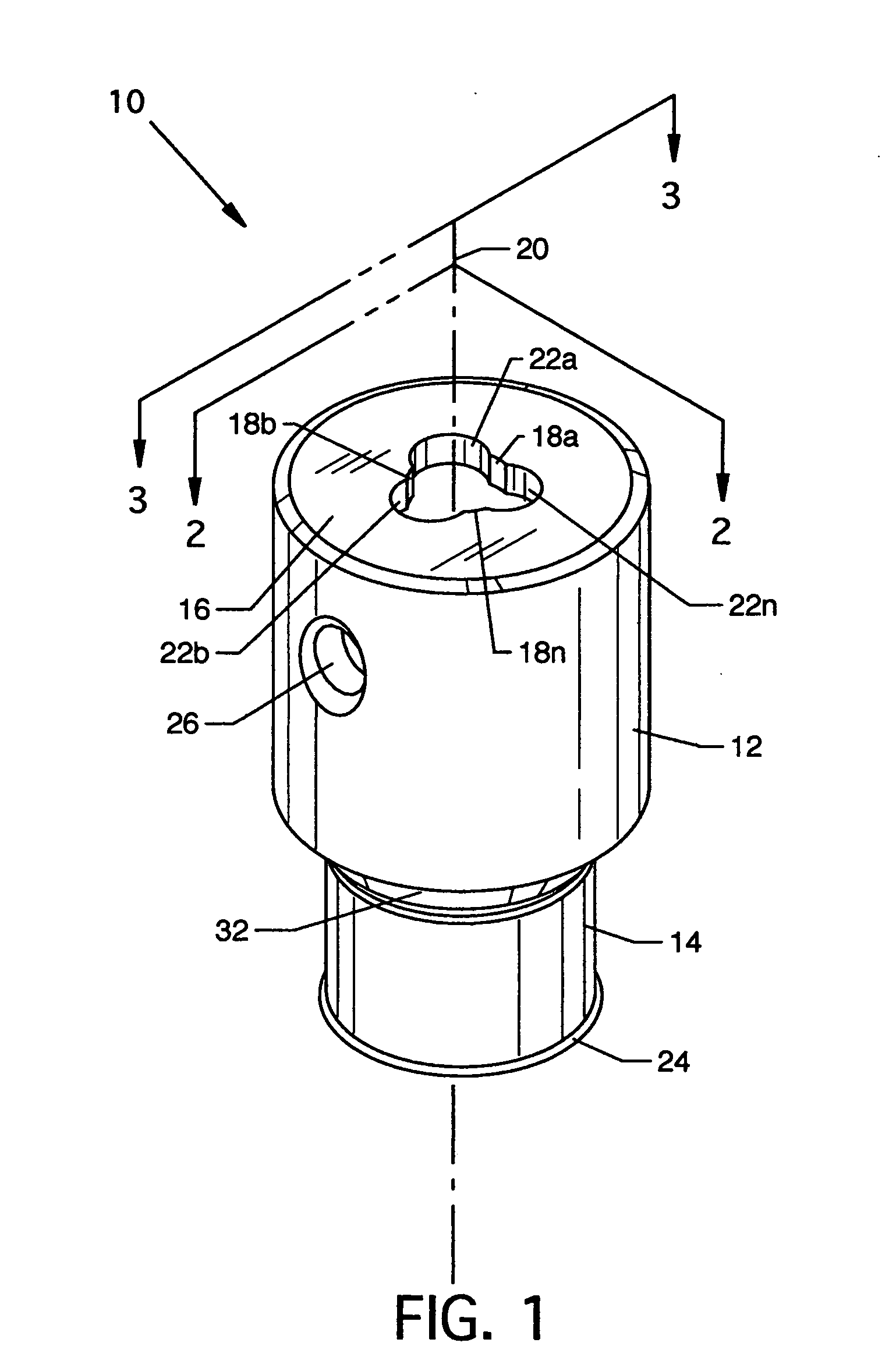[0022] The
general purpose of the present invention is to provide an ultrasound probe positioning immersion shell. To achieve the objectives for correct ultrasound probe positioning during immersion A-scan, an ultrasound probe positioning immersion shell, a unique immersion shell, has been developed. The ultrasound probe positioning immersion shell consistently places the ultrasound probe perpendicular to and at the correct distance from the corneal plane. The ultrasound probe positioning immersion shell has a fluid flow arrangement to ensure suitable filling of a lower chamber while minimizing
air bubble formation which can disrupt or otherwise influence the ultrasound measuring process. The preferred methods to achieve the perpendicular ultrasound probe position are to have one continuous guide or, preferably, to have two or more separate opposed guide rings which can be externally and internally located with each having centrally located structures providing at least three arcuate guide surfaces for intimate contact with the cylindrical or tapered shape of an ultrasound probe, respectively. The configuration of each of the externally and internally located guide rings includes centrally located arcuate guide surfaces which accommodate the ultrasound probe and, additionally, at least include three vents which can be arcuate, which are offset from the centerline of the ultrasound probe positioning immersion shell, and which intersect the centrally located arcuate guide surfaces, thereby creating a
scallop-like pattern. This pattern creates at least three points of ultrasound probe contact at each guide ring location and at least three vents about the intersection of the ultrasound probe and the respective external and internal guide rings. Two or more guide rings, used for positioning the ultrasound probe, result in partial defining of separate internal upper and lower chambers, where the upper chamber is between the external guide ring, the internal guide ring and an upper cylindrical body, and where the lower chamber, which is open at one end, is bounded by the internal guide ring and a lower cylindrical body and a lip. The vents in the internal guide ring allow for the transfer of
liquid medium to drain from the upper chamber to the lower chamber. The external guide
ring pattern allows for air pressure
equalization to
ambient air when
liquid medium is introduced and when the ultrasound probe is centered in the external guide ring. Self-positioning of the ultrasound probe
transducer is accomplished by the arcuate guide surfaces of the external and internal guide rings contacting the ultrasound probe at a minimum of two separate
body regions to ensure perpendicular positioning of the ultrasound probe in the ultrasound probe positioning immersion shell. A fluid transfer port located in the upper portion of the ultrasound probe positioning immersion shell allows for various methods of filling the
liquid medium. The fluid transfer port is located away from the base of the ultrasound probe positioning immersion shell so that it will be away from the eye to improve operator
visualization during placement of the instrument. The ultrasound probe positioning immersion shell can be fashioned of transparent material to monitor placement on the eye and to monitor the liquid medium level.
[0023] The ultrasound probe positioning immersion shell self-positions the ultrasound probe in the ultrasound probe positioning immersion shell perpendicular to the ultrasound probe positioning immersion shell lower chamber lip horizontal plane and places the ultrasound probe at a specified height from the
corneal surface to optimize axial length ultrasound measurement. The geometry and size of the external arcuate guide surfaces and internal arcuate guide surfaces form an automatic stop with respect to depth and also provide a safety feature that does not allow the ultrasound probe to be placed lower than the specified depth for an optimum A-scan, thereby avoiding accidental contact with the eye. After the ultrasound probe is inserted into the ultrasound probe positioning immersion shell to the automatic stop position, the ultrasound probe positioning immersion shell is then placed on the eye.
Liquid medium is filled through the fluid transfer port with low pressure to eliminate the possibility of eye
tissue damage from the fluid flowing into the ultrasound probe positioning immersion shell. The external and internal arcuate vents greatly reduce the possibility of
air bubble formation.
[0026] Another significant aspect and feature of the present invention is an ultrasound probe positioning immersion shell which eliminates or minimizes air bubble formation.
[0030] Still another significant aspect and feature of the present invention is geometry which limits the travel of an ultrasound probe along the central axis and acts as a stop.
 Login to View More
Login to View More  Login to View More
Login to View More 


